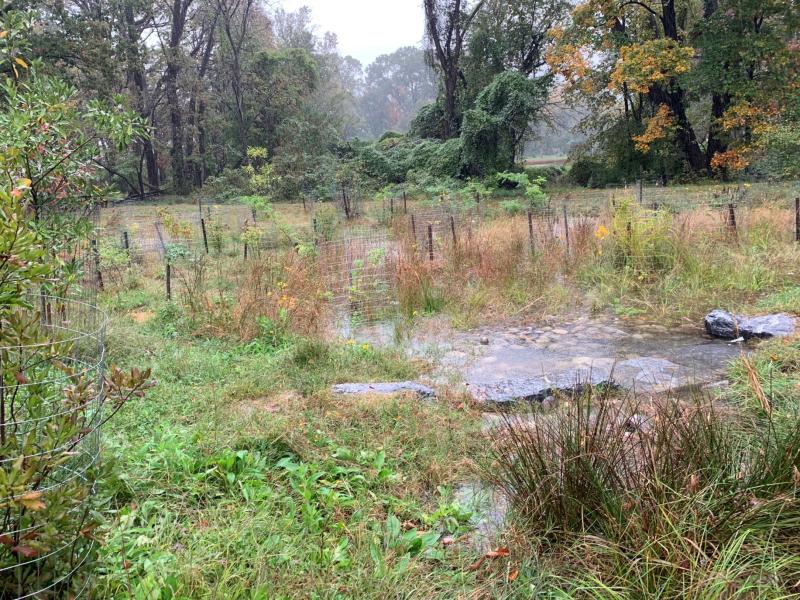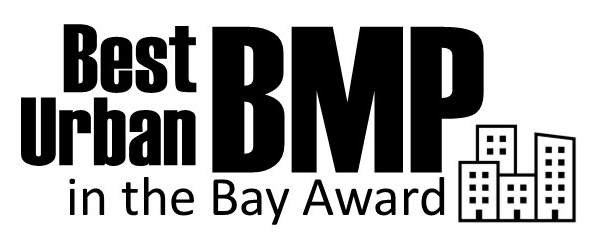<< Back to Innovative Stormwater Retrofits main page

The Project Area was identified as a priority restoration area by U.S. Fish and Wildlife Service (FWS), National Park Service (NPS) and the District Department of Energy & Environment (DOEE) due to its impact on existing habitat along Rock Creek.
 The targeted 11‐acre impervious area had no stormwater controls because it was developed prior to the institution of the District's current stormwater regulations. During rain events, stormwater swiftly left the Project Area from the parking lot, where it was shed down the hillside, concentrating flows into highly erodible gullies, resulting in swift, cascading flows that carry heavy sediment loads and bypass infiltration and groundwater recharge (due to their high flow rates), and therefore impacting and reducing native habitat along Rock Creek. Five distinct gullies had been created by stormwater draining from the parking lot.
The targeted 11‐acre impervious area had no stormwater controls because it was developed prior to the institution of the District's current stormwater regulations. During rain events, stormwater swiftly left the Project Area from the parking lot, where it was shed down the hillside, concentrating flows into highly erodible gullies, resulting in swift, cascading flows that carry heavy sediment loads and bypass infiltration and groundwater recharge (due to their high flow rates), and therefore impacting and reducing native habitat along Rock Creek. Five distinct gullies had been created by stormwater draining from the parking lot.
The goal of the Project was to fully retrofit the targeted 11‐acre impervious area with green infrastructure to restore natural hydrology, prevent erosion, reduce stormwater pollution, and protect and restore existing natural habitat for federally listed endangered and other native species.
The beauty of this project is that it achieves multiple goals, including stabilizing eroding gullies and zero-order streams; promoting stormwater infiltration / groundwater recharge; protecting habitat of federally listed endangered species (and habitat for other species); reducing the risk of downstream flooding; and improving water quality. The project accomplishes these objectives in the following ways:
- Protects habitat by reducing erosive stormwater flows from project site outfalls while improving habitat for all water-dependent species by raising the groundwater table, increasing base flow in existing seeps necessary for aquatic habitat, and potentially creating new ones;
- Reduces the risk of downstream flooding – particularly in the Blagden Run watershed where the project area makes up approximately 15% of the watershed’s impervious surface – by reducing peak flows and increasing the time of concentration for stormwater leaving the project area;
- Improves water quality by treating up to the 1.2-inch storm event (90% or less of all storms in the District every year) through the use of green infrastructure or Low Impact Development (LID) techniques. LID has been shown to remove stormwater pollutants including sediment metals, trash and other organic compounds, which are particularly associated with runoff from parking lots.
This project effectively manages over 150,000 gallons a year of stormwater runoff generated from the surrounding ~nearly 16 acres of developed, ultra-urban land resulting in an estimated annual pollutant load reduction of 4.70 pounds of Nitrogen, 117.5 pounds of Phosphorus and 6,181 pounds of Sediment - which is kept out of Blagden Run, Rock Creek, and the Chesapeake Bay!
 Several different innovative techniques were utilized throughout this project to ensure minimal/low impact to the surrounding natural environment of Rock Creek Park and to cost-effectively test promising new approaches resulting in the project receiving the highly sought-after designation of the Best Urban (Retrofit) BMP in the Bay Award (by the Chesapeake Stormwater Network).
Several different innovative techniques were utilized throughout this project to ensure minimal/low impact to the surrounding natural environment of Rock Creek Park and to cost-effectively test promising new approaches resulting in the project receiving the highly sought-after designation of the Best Urban (Retrofit) BMP in the Bay Award (by the Chesapeake Stormwater Network).
To learn more about the project, please see the various resources below:
- DOEE Annual MS4 Report (2020) StoryMap: Highlight on Carter Barron Stormwater Retrofit Project
- The BUBBAs award project
- A short video on the innovative techniques used throughout the project
Final Designs
Project Status: This project is now complete.
Additional Project Documents

